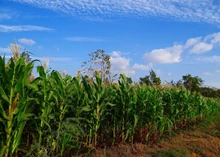
Jammu and Kashmir is predominantly an agrarian economy with about 80% of its population engaged in agriculture and allied sectors. The agro-climatic diversity of state varies from sub-tropical in Jammu to temperate in Kashmir.
Agriculture in the hills and mountains suffers from an inherent constraint of remoteness and inaccessibility, fragility in terms of moisture stress and poor soil conditions and short growing season. Arable lands are about 18% of the total geographical area, whereas the net sown area is only about 7%. More than half of the cultivable area is un- irrigated.
Though area, production and productivity of different crops have increased over time, the rate of development has been very slow. The cropping intensity in Jammu region is reported to be 176%, whereas in Kashmir it is close to 123%.
Agriculture, overtime, has also become relatively less remunerative profession due to low yields, despite consistent accretion in the usage of a range of inputs, unfavourable price regime and low value addition.

Monsoon
The Jammu region is home to high quality ‘Basmati’, ‘Rajmash’, Black Caraway (‘zeera’) etc., while, Kashmir region is rich in high quality Saffron, ‘Zeera’, fresh and dry temperate fruits and commercial floriculture.
All-India crop yield index shows a strong relationship with all-India summer monsoon rainfall. Crops grown in both the monsoon (Kharif) and the post-monsoon (Rabi) seasons respond significantly to the summer monsoon.
Kharif (summer) is the main crop growing season over India. Food grain yield during Kharif season is directly affected by day-to-day variations of summer monsoon (June through September) precipitation. An increase (decrease) in food grain yield is generally associated with an increase (decrease) in rainfall.

Agro-advisory for Jammu region
1. For management of downy mildew of cucumber, farmers are advised for spraying of metalaxyl 8% + mancozeb 64% @ 0.25% (0.25g/L of water)
2. For management of early blight of tomato, farmers are advised to spray mancozeb @ 0.25%
3. Button mushroom may be processed into pickle after proper washing, sorting, cutting, blanching, adding spices and oil and packing in jars.
4. The oyster mushroom may also be used for pickle preparation but should not be washed and blanched
5. Button /oyster mushroom can also be dried after cutting/ slicing. The button mushroom because of compact fruit body is required to be sliced and spread on a muslin cloth in a thin layer in the sun so that it is dried fast
6. Irrigate summer pulses as and when required
Advisory for enhancing production in irrigated rice
1. Proper time of raising nursery is from mid to last week of May. Incorporate 15Kg of well rotten FYM/compost, 60g Urea and 50g DAP for each 10m2nursery area
2. Use sprouted seeds for wet nursery. Nursery should be kept free from weeds by mechanical methods or by use of Butachlor granules 5G @ 30kg/ha in the puddle soil after emergence of first leaf.
3. In case of dry sowing, sow seeds in lines 5cm apart and 3cm deep
4. For nursery sowing, immerse seed in water in 1:1 ratio using carbendazim 0.2% or Thiram 0.3% plus streptocycline 100ppm (1g/10L of water) for 12 hours and sow directly.
5. Recommended varieties upto 800m elevation zone of Jammu are IET 1410, China-1039, K-39, Ratna, PC-19, Jaya, RR-8585 (Ajay), Basmati 370, Ranbir Basmati, Saanwal Basmati, and hybrids KRH-2 and PHB-71.
6. Recommended varieties for intermediate zone b/w 800-1500 m are China-1039, Saanwal Basmati, K-39, K-84, K-343; and Giza-14 where hailstorms are frequent
7. Use 40-45 Kg/ha seed for coarse varieties , 35-40 Kg/ha for semi fine varieties and 15 Kg/ha for hybrids
Advisory for enhancing production of rainfed maize
1. Carry out earthing up in the crop at knee-high stage, i.e., one month after sowing. For chemical weed control, apply atrazine 1 Kg/ha in 800-1000L of water as pre-emergence herbicide. One weeding should be given at 30 days after sowing
Advisory for enhancing production of Vegetables
1. In intermediate lower zone, nursery of Brinjal (Pusa Purple Long, Pusa Purple Cluster, Pusa Purple Round); Chillies (NP-46 A, Pusa Jwala) in sub-tropical zone, Cauliflower (Pusa Deepali) may be taken
2. In intermediate higher zone, Brinjal, Chillies, Cabbage (Golden Acre, Pride of India), Cauliflower (Pusa Snowball, Snowball-16, Pusa Snowball K-1) and KnolKhol (White Vienna and Purple Vienna) can be sown
3. In temperate/intermediate higher zone, transplanting of tomato (Pusa Ruby, S-1, Marglobe) at 60×45 cm, Brinjal (PPL, PPC, PPR, Pusa Kranti) at 60×45 cm and KnolKhol (White Vienna) at 30×20 cm can be done
4. In sub-tropical zone, Bhindi (Pusa Kranti, Varsha Uphar, A-4) with seed rate of 12-15 kg/ha can be planted at 60×30 cm, Radish (Pusa Chetki) with seed rate of 10-12 Kg/ha at a spacing of 45×15 cm can be planted
5. Regularly rouge out virus/mycoplasma infected brinjal, chillies, tomato, potato etc plants. For leaf spot/blight and downy mildew of cucurbits, spray mancozeb 0.2% or COC @ 0.3%. Seed treatment with carbendazim 0.2%, thiram 0.3% or captan @ 0.3%
6. For fruitfly infestation in cucurbits, spray bait mixture (malathion 1ml + 10g sugar in one litre of water) @ 500L/ha. For, fruit orer in tomato, brinjal and bhindi crop, spray carbaryl (0.1%) or dichlorvos 76EC (0.03%)
Advisory for Apriculture
Provide adequate space to the colonies for brood rearing and storage of nectar. Maximum number of comb foundation sheets be got raised by inserting newly fixed sheets in between the two drawn frames.
Provide supers well in time to avoid congestion and proper storage of honey. Keep colonies in shade or cover with wet gunny bags.
Agro-advisory for Kashmir region
1. Recommended rice varieties are Shalimar Rice-1 and Shalimar Rice-3 for areas below an altitude of 1,650m. Shalimar Rice-4 variety is recommended upto altitude of 1,700m. Shalimar Rice-2 variety is recommended for low lying and waterlogged areas. K-332 and Shalimar Rice-5 varieties are cold tolerant and suitable for higher belts of an altitude above 2,000m
2. The transplanting should be completed between last week of May to 2ndweek of June when the rice seedling is 28-30 days old. Any delay in transplanting beyond this date results in a significant yield decline
3. Important maize varieties are Shalimar Maize Composite-4, Shalimar Maize Hybrid-2, Shalimar Maize Composite-7, Vivek-45, Pusa Vivek QPM-9, Vivek-53, DMRH-1530 and DMRH-1305 for areas below an altitude of 1,850m
4. Shalimar KG Maize-1, Shalimar KG Maize-2, Shalimar Maize Composite-3, Shalimar Maize Hybrid-1, Shalimar Maize Composite-6 are recommended for higher belts above an altitude of 1,850m
5. Apply atrazine 50 WP @ 2kg/ha 2-3 days after sowing as pre-emergence herbicide in maize
6. Carry out earthing up/ hoeing at knee high stage of maize, i.e., 30 days after sowing
7. For apple crop, orchardists are advised to spray difenaconazole 30ml or flusilazole 20ml or trifloxystrobin 40g/ 100 L of water at petal fall stage (> 60%) for scab.
8. In case of mite attack in apple orchards use hexythiazaox 40ml, or spiromesifen 40ml or fenazaquin 40ml per 100L of water
Due to undulating hilly terrain and limited accessibility, the farmers of Jammu and Kashmir face various constraints in increasing their crop productivity. The advice provided to farmers through ICAR, aimed at enhancing the effectiveness of knowledge dissemination to far flung areas of the country. These advisories will help the farmers of the state in improving their farm productivity.
(Source: ICAR)










